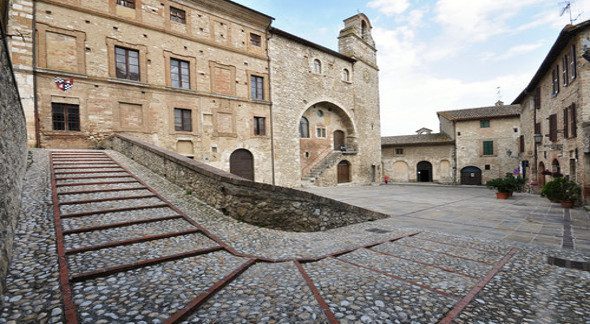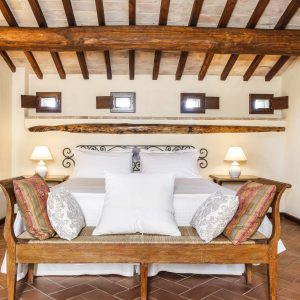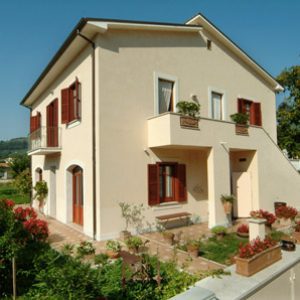▌ Alla scoperta di San Gemini
#BELLAUMBRIA
{“translation”:[{“lang”:”it”,”content”:”
San Gemini, originario borgo preromano denominato Casventum in epoca romana, assunse l’odierno nome nel IX secolo, quando un monaco di nome Gemine, proveniente dalla Siria, vi cominciò a predicare, istruendo e beneficando a tal punto da far designare la cittadna come la città di “Santo Gemine”.
>>Vuoi vedere Sangemini? Consulta ora le offerte dei migliori hotel nelle vicinanze.
Divenuta location con il favore del Papato, ed essendo un nodo stradale di vitale importanza per le comunicazioni con Roma da nord, la cittadina divenne un centro culturale, artistico e religioso di prim’ordine. Ne son testimonianza le Abbazie di San Nicolò e di San Gemine, oggi duomo, le chiese di San Giovanni, con un antico Battistero dell’VIII secolo, e di San Francesco (sec. XIII), nonchè il Palazzo del Capitano del Popolo e la poderosa Cinta Muraria ancora visibile in larghi tratti.

>> Ci sono offerte in scadenza per b&b nella zone di Sangemini! Clicca e consultale subito.
Piazza San Francesco, la più grande della città, è dominata dalla mole turrita del Palazzo Canova, testimonianza del lungo soggiorno in San Gemini del grande scultore. Numerosi altri resti storici, come la raccolta cappella di Santa Maria de Incertis e le chiese di Santa Maria Maddalena e Santo Stefano, e bellezze architettoniche come torrioni, case-torri, scalinate, arcate, bastioni, ponticelli di sostegno, severi edifici, nonché la vicinanza con i resti della bella città romana di Carsulae e con le Terme le cui acque portano il suo nome, concorrono a rendere San Gemini pari ad un gioiello che riempie di meraviglia e di ammirazione il visitatore che si addentra nelle sue viuzze e ne scopre gradatamente le varie sfaccettature.
La più importante manifestazione organizzata nel paese è la rievocazione storica della Giostra dell’Arme e Le Gioie e l’Indiscreto.
“},{“lang”:”en”,”content”:”San Gemini, original pre-roman town called Casventum in Roman times, took on the present name in the 9th century, when a monk called Gemine from Syria began to preach there, instructing and doing so much good that the town became known as the city of “St. Gemine”.
Enjoying the favour of the Papal State, it became a township, and representing a road junction of vital importance for comunication with Rome to the north, the town became a primary center of culture, art and religion. The abbeys of St. Nicholas and St. Gemine, now a cathedral, the churches of St. John with its antique baptistery of the 8th century and of St. Francis (13th century), as well as the Palace of the Citizen’s Captain and the mighty city walls, which largely still exist, testify to this fact. The Square of St. Francis, which is the town’s largest square, is dominated by the turreted mole of Canova Palace, testimony of the great sculptor’s long stay at San Gemini. Numerous other historical remains such as the quiet chapel of St. Mary de Incertis and the churches of St. Mary Magdalen and St. Steven, and architectonic beauties such as mighty towers, tower-houses, steps, arcades, bastions, sustaining small bridges and austere buildings, added to the proximity to the beautiful Roman city of Carsulae and to the Baths whose mineral waters take the town’s name, all contribute to make San Gemini a jewel which makes the visitor who passes within its small lanes and gradually discovers its various facettes marvel and filled with admiration.
The most important manifestations taking place in the town we should absolutely mention the historical events Giostra (Joust) dell’Arme and Le Gioie e l’Indiscreto (The Joys and the Indiscreet)”.
“},{“lang”:”es”,”content”:”San Gemini, original pre-roman town called Casventum in Roman times, took on the present name in the 9th century, when a monk called Gemine from Syria began to preach there, instructing and doing so much good that the town became known as the city of “St. Gemine”.
Enjoying the favour of the Papal State, it became a township, and representing a road junction of vital importance for comunication with Rome to the north, the town became a primary center of culture, art and religion. The abbeys of St. Nicholas and St. Gemine, now a cathedral, the churches of St. John with its antique baptistery of the 8th century and of St. Francis (13th century), as well as the Palace of the Citizen’s Captain and the mighty city walls, which largely still exist, testify to this fact. The Square of St. Francis, which is the town’s largest square, is dominated by the turreted mole of Canova Palace, testimony of the great sculptor’s long stay at San Gemini. Numerous other historical remains such as the quiet chapel of St. Mary de Incertis and the churches of St. Mary Magdalen and St. Steven, and architectonic beauties such as mighty towers, tower-houses, steps, arcades, bastions, sustaining small bridges and austere buildings, added to the proximity to the beautiful Roman city of Carsulae and to the Baths whose mineral waters take the town’s name, all contribute to make San Gemini a jewel which makes the visitor who passes within its small lanes and gradually discovers its various facettes marvel and filled with admiration.
The most important manifestations taking place in the town we should absolutely mention the historical events Giostra (Joust) dell’Arme and Le Gioie e l’Indiscreto (The Joys and the Indiscreet)”.
“},{“lang”:”de”,”content”:”San Gemini, original pre-roman town called Casventum in Roman times, took on the present name in the 9th century, when a monk called Gemine from Syria began to preach there, instructing and doing so much good that the town became known as the city of “St. Gemine”.
Enjoying the favour of the Papal State, it became a township, and representing a road junction of vital importance for comunication with Rome to the north, the town became a primary center of culture, art and religion. The abbeys of St. Nicholas and St. Gemine, now a cathedral, the churches of St. John with its antique baptistery of the 8th century and of St. Francis (13th century), as well as the Palace of the Citizen’s Captain and the mighty city walls, which largely still exist, testify to this fact. The Square of St. Francis, which is the town’s largest square, is dominated by the turreted mole of Canova Palace, testimony of the great sculptor’s long stay at San Gemini. Numerous other historical remains such as the quiet chapel of St. Mary de Incertis and the churches of St. Mary Magdalen and St. Steven, and architectonic beauties such as mighty towers, tower-houses, steps, arcades, bastions, sustaining small bridges and austere buildings, added to the proximity to the beautiful Roman city of Carsulae and to the Baths whose mineral waters take the town’s name, all contribute to make San Gemini a jewel which makes the visitor who passes within its small lanes and gradually discovers its various facettes marvel and filled with admiration.
The most important manifestations taking place in the town we should absolutely mention the historical events Giostra (Joust) dell’Arme and Le Gioie e l’Indiscreto (The Joys and the Indiscreet)”.
“},{“lang”:”fr”,”content”:”San Gemini, village d’origine pré-romaine appelé Casventum à l’époque romaine, il prend le nom actuel au IXème siècle, quand un moine prénommé Gemine, venant de la Syrie, commence à y prêcher, en enseignant et en procurant un tel bénéfice à la ville qu’elle en devient la ville de “Saint Gemine”.
Devenue Commune par la grâce de la Papauté, et étant un noud routier d’une importance vitale pour les communications avec Rome à partir du nord, la petite ville devient un centre culturel, artistique et religieux de premier ordre.
En témoignenf les Abbayes de San Nicolò et de San Gemine, aujourd’hui cathédrale, les églises de San Giovanni, avec son antique fonds baptismal du VIIIème siècle, et de Saint François (XIIIème siècle), ainsi que le Palazzo del Capitano del Popolo et la puissante Enceinte de Murs encore visible en de nombreux endroits.
Piazza San Francesco, la plus grande place de la ville, est dominée par la masse munie de tours du Palazzo Canova, témoignage du long séjour à San Gemini du grand sculpteur. De nombreux autres restes historiques, comme la chapelle de Sainte Marie de Incertis et les églises de Sainte Marie Madeleine et Saint Stéphane, et les beautés architectoniques comme tours, maisons-tours, escaliers, arcades, bastions, petits ponts de soutien, édifices sévères, ainsi que la présence non loin de là des restes de la belle cité romaine de Carsulae et des Thermes dont les eaux portent son nom, font de San Gemini un bijou qui remplit d’émerveillement et d’admiration le visiteur qui pénètre dans ses petites rues et en découvre graduellement les diverses facettes. La plus importante manifestation organisée dans le village est l’évocation historique du Giostra (Joust) dell’Arme and Le Gioie e l’Indiscreto (The Joys and the Indiscreet)”.
“}]}







